Structure of the Granitic Pegmatite Field of the Northern Coast of Portugal—Inner Pegmatite Structures and Mineralogical Fabrics
Abstract
1. Introduction
2. Geological and Tectonic Framework
- 1st folding phase (D1) is marked by folds with vertical axial planes and a metamorphic surface, with the same attitude, established in a ductile regime;
- 2nd folding phase (D2), characterized by the generation of recumbent folds, associated with significant tectonic transport, laminating the previous structures, especially at the inverse fold flanks and a metamorphic surface, with the same attitude, established in a ductile regime;
- 3rd folding phase (D3), generation of folds with subvertical axial planes, with a trajectory subparallel to the Ibero-Armorican Arc, occasionally producing a metamorphic flow and axial plane surface, also very inclined to vertical.
- Opening of the Rheic ocean, between Gondwana and Avalony—Cambrian-Ordovician (500–470 Ma);
- Subduction of the SE margin of the Rheic ocean associated with the retro-arc opening of the ocean Paleothetys—Ordovician to the Silurian (430–390 Ma);
- Separation of Armórica/Iberia, by opening of Paleothetys—distensive context;
- Closing of the oceans Rheic and Paleotethys (Low to Medium Devonian, 390–370 Ma) and collision due to the Variscan Orogeny, between Iberia and Armorica;
- Collision of Avalonia with Gondwana—end of Variscan Orogeny.
3. Methods
- Detailed geometric analysis (high resolution cartography) of pegmatites and internal, linear and planar fabrics of spodumene;
- Geometric analysis of the variability of the pegmatite inner structure and the fabric of spodumene lodged therein, in distinct sectors of NCPF, which are considered to be representatives of this variability—the Moledo to Afife Sector to the North, where the pegmatites are hosted in two mica gneisses with tourmaline and garnet, and the Pedras Ruivas Sector, in the southern part, where the pegmatites were implanted in quartzites and meta-quartzphyllite (Figure 1 and Table 1);
- Interpretation of structures resulting from imposed and superimposed deformation, from the point of view of displacement kinematics, considering the rheological behavior of host rocks in different deformational regimes.
4. Structural Analysis of the Pegmatites Network
4.1. Moledo
4.2. Afife
4.3. Pedras Ruivas
5. Modes of Occurrence of Spodumene
- Comb structure due to centripetal growth nucleated at the pegmatite contact;
- Dissemination of phenocrysts in a magmatic flow, highlighting the planar and linear imbrications according to the fluidalities’ motion in the fine granular matrix, sometimes typically aplitic;
- Occurrence as mega to giga-crystals of sheared spodumene, due to orthogonal shortening or extension associated with shear in low viscosity state or in a ductile regime after the crystallization of the surrounding mesostasis—spodumenes present contours according to the surrounding c/s surfaces.
- Type I—narrow tabular bodies with spodumene in early comb-structures (Figure 8);
- Type II—tabular bodies with metrical width with spodumene, tourmaline, garnet and apatite-megacrysts of spodumene were observed in comb and flow structures (Figure 9);
- Type III—tabular to lenticular bodies of variable thickness, with very deformed spodumene (cataclastic to milonitic and pseudomorphic in phyllosilicates) associated with well-defined c/s (shear) structures (Figure 11);
- Type IV—lenticular bodies with spodumene units in late dilations, constituting pull-apart structures.
6. Discussion
7. Conclusions
Author Contributions
Funding
Conflicts of Interest
References
- Doblas, M. Slickenside kinematic indicators. Tectonophysics 1998, 295, 187–197. [Google Scholar] [CrossRef]
- Lima, F. Itinerários Geológicos do Alto-Minho—Estudo de locais de Interesse Geológico. Master’s Thesis, Universidade do Minho, Gualtar, Portugal, 1996; p. 215. [Google Scholar]
- Lima, F. Caracterização e Estratégias de Valorização Sustentável de Ocorrências Geológicas com Importância Patrimonial. Ph.D. Thesis, Universidade do Minho, Gualtar, Portugal, 2006; p. 336. [Google Scholar]
- Lima, F.; Leal Gomes, C. Locais de Interesse Geológico e Arquelógico-Mineiro no Noroeste de Minho; IGM e CM Lousal: Lousal, Portugal, 1998. [Google Scholar]
- Lima, F.; Leal Gomes, C. Locais de Interesse Para a Arqueologia Mineira do Alto Minho (N. de Portugal) Estado Actual-métodos de Caracterização e Estratégias de Aproveitamento. Cadernos do Laboratório Xeolóxico de Laxe 1998, 23, 89–99. [Google Scholar]
- Lima, F.; Leal Gomes, C. Actas do I Seminário Sobre Património Geológico Português; IGM: Alfragide, Portugal, 1999; p. 6. [Google Scholar]
- Brisbin, W.C. Mechanics of pegmatite intrusion. Am. Mineral. 1986, 71, 644–651. [Google Scholar]
- Phillips, W.J. Hydraulic fracturing and mineralization. J. Geol. Soc. Lond. 1972, 128, 337–359. [Google Scholar] [CrossRef]
- Phillips, W.J. The dynamic emplacement of cone sheets. Tectonophysics 1974, 24, 69–84. [Google Scholar] [CrossRef]
- Roberts, J.L. The intrusion of magma into brittle rocks. Mech. Igneous Intrusion 1970, 2, 287–338. [Google Scholar]
- Leal Gomes, C.; Lopes Nunes, J.E. Análise paragenética e classificação dos pegmatitos graníticos da Cintura Hercínica Centro-Ibérica. In A Geologia de Engenharia e os Recursos Geológicos; I. da U. de Coimbra: Coimbra, Portugal, 2003; pp. 85–109. [Google Scholar]
- Cerny, P.; Ercit, T. The classification of granitic pegmatites revisited. Can. Miner. 2005, 43, 2005–2026. [Google Scholar] [CrossRef]
- Cerny, P. Anatomy and classification of granitic pegmatites. Granitic Pegmatites Sci. Ind. 1982, 1–39. [Google Scholar]
- Pereira, E. Folha 1—Minho—Carta geológica de Portugal à escala 1:200.000. Serv. Geol. Portugal. 1989. [Google Scholar]
- Leal Gomes, C. Minuta (SINGULAR) de revisão da Folha 1C-Caminha. Carta geológica de Portugal na escala 1: 50 000. 2008. Available online: https://repositorium.sdum.uminho.pt/handle/1822/33593 (accessed on 24 January 2019).
- Dias, R.; Araújo, A.A.; Terrinha, P.; Kullberg, J.C. Geologia de Portugal, Volume I, Geologia Pré-mesozóica de Portugal; Escolar Editora: Maputo, Mozambique, 2013. [Google Scholar]
- Lotze, F. Zur Gliederung der Varisziden der Iberischen Meseta. Geotekt. Forschg 1945, 6, 78–92. [Google Scholar]
- Julivert, M.; Fontboté, J.; Ribeiro, A.; Conde, L. Memória explicativa del Mapa Tectónico de la Península Ibérica y Baleares. Escala 1/100000. Inst. Geol. Min. España Madrid 1974, 133. [Google Scholar]
- Farias, P.; Gallastegui, G.; Lodeiro, F.G.; Marquinez, J.; Parra, L.M.M.; Catalán, J.R.M.; Maciá, J.G.P.; Fernandez, L.R. Aportaciones al conocimiento de la estratigrafía y estrutura de Galicia Central. Mem. An Fac. Cien. Univ. Porto 1987, 1, 411–431. [Google Scholar]
- Ribeiro, A.; Munhá, J.; Dias, R.; Mateus, A.; Pereira, E.; Ribeiro, L.; Fonseca, P.; Araújo, A.; Oliveira, T.; Romão, J.; et al. Geodynamic evolution of the SW Europe Variscides. Tectonics 2007, 26. [Google Scholar] [CrossRef]
- Leal Gomes, C. Estudo Estrutural e Paragenético de um Sistema Pegmatóide Granítico–o Campo Splito-Pegmatítico de Arga Minho, Portugal. Unpubl. Ph.D. Thesis, Minho University, Gualtar, Portugal, 1994. [Google Scholar]
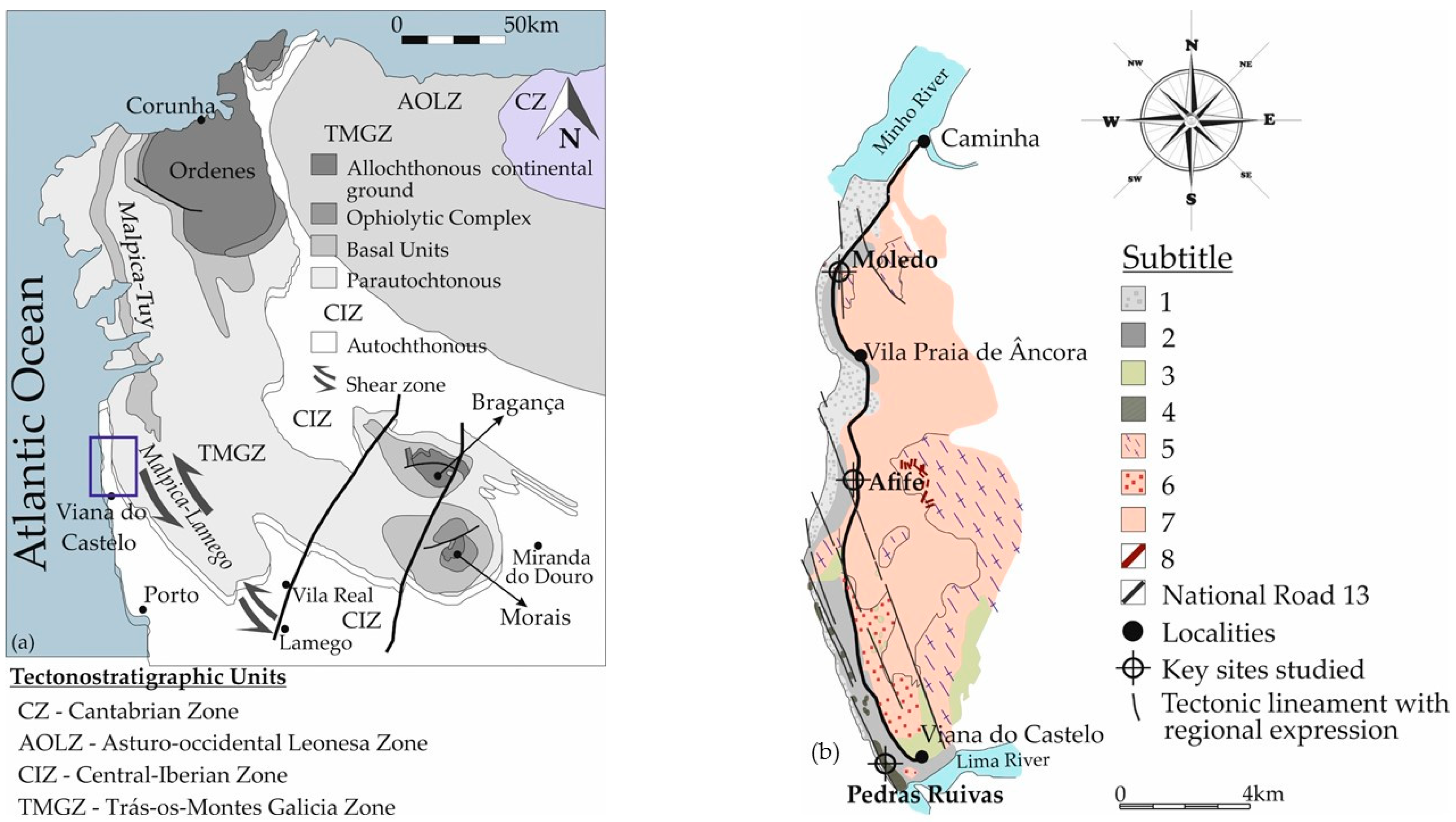
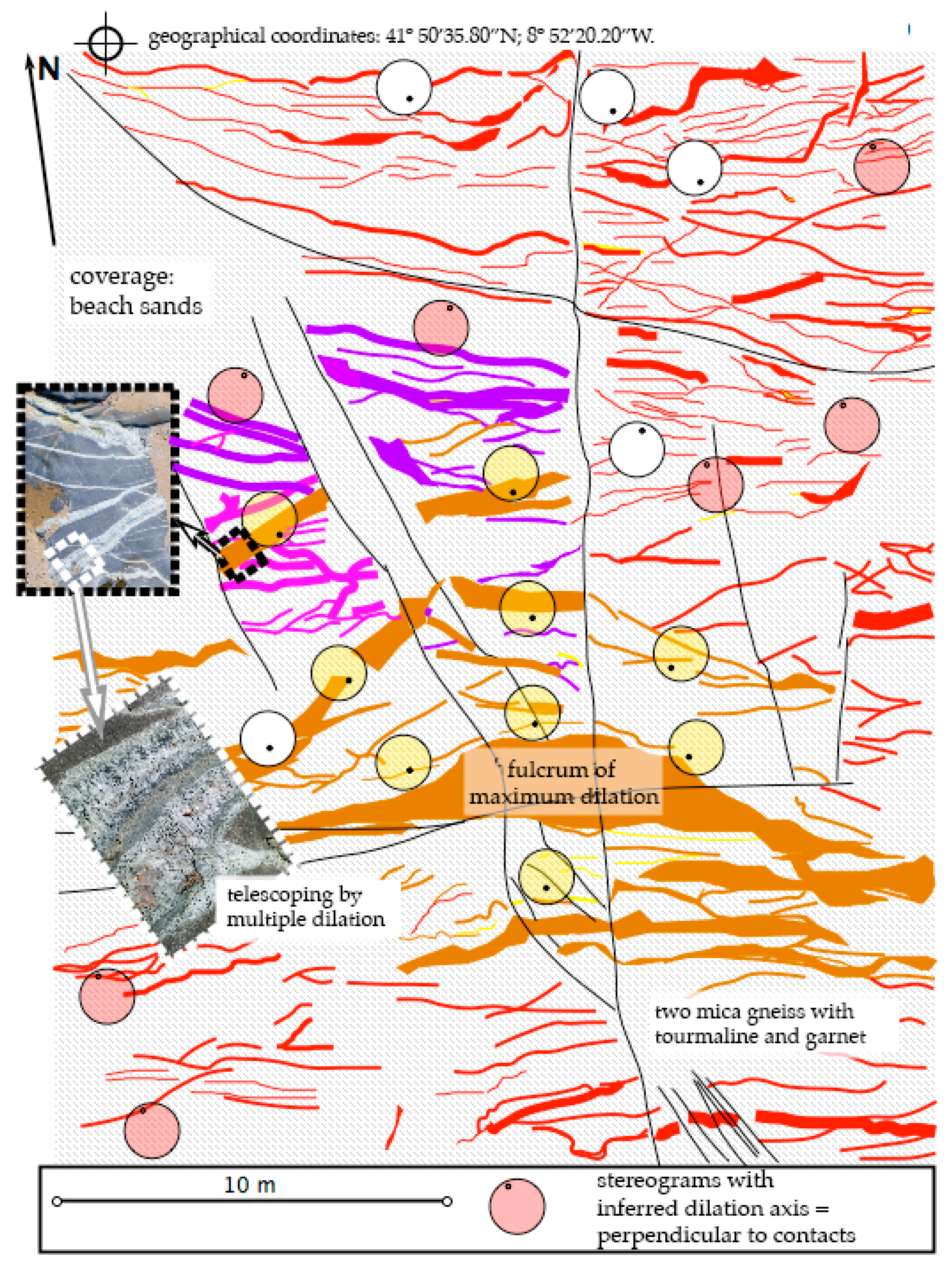
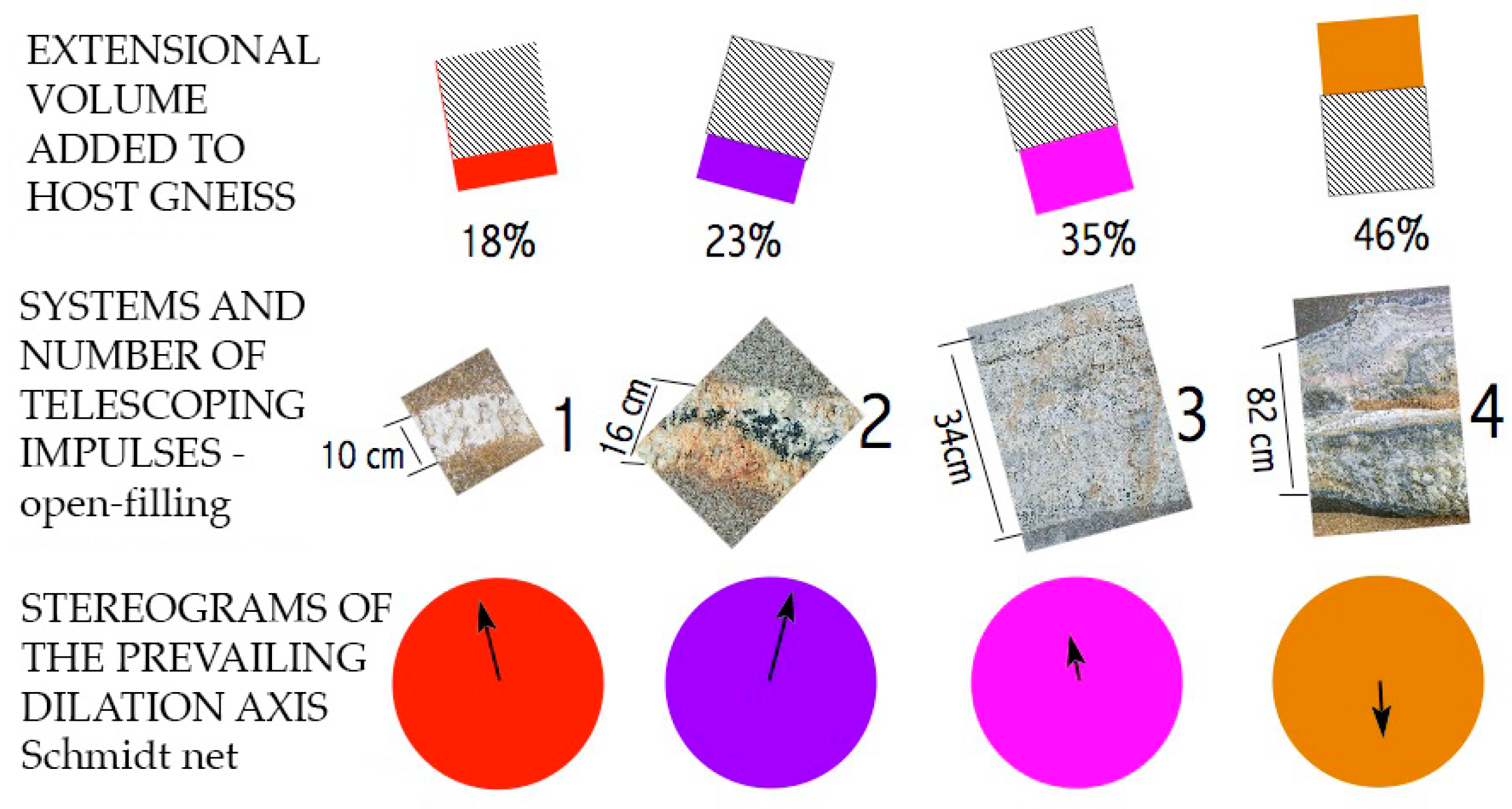
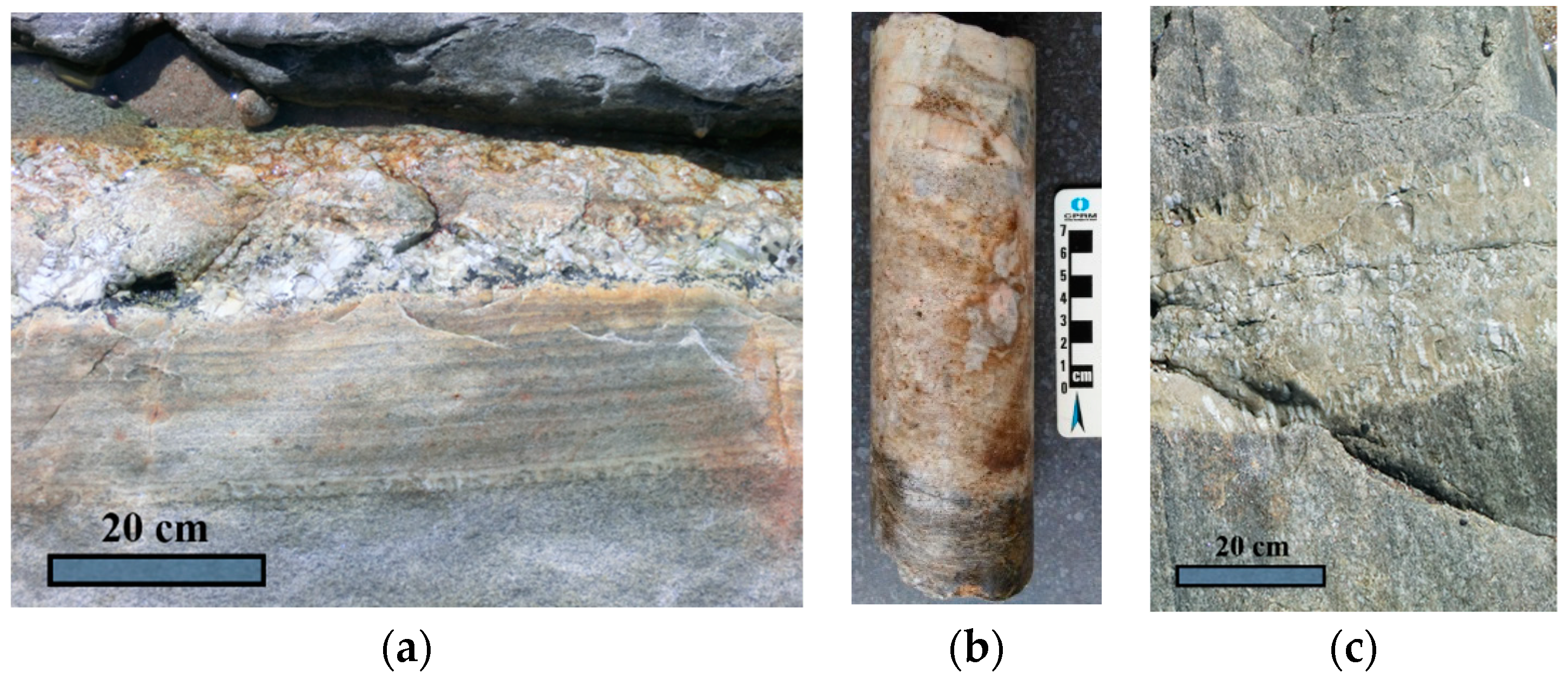

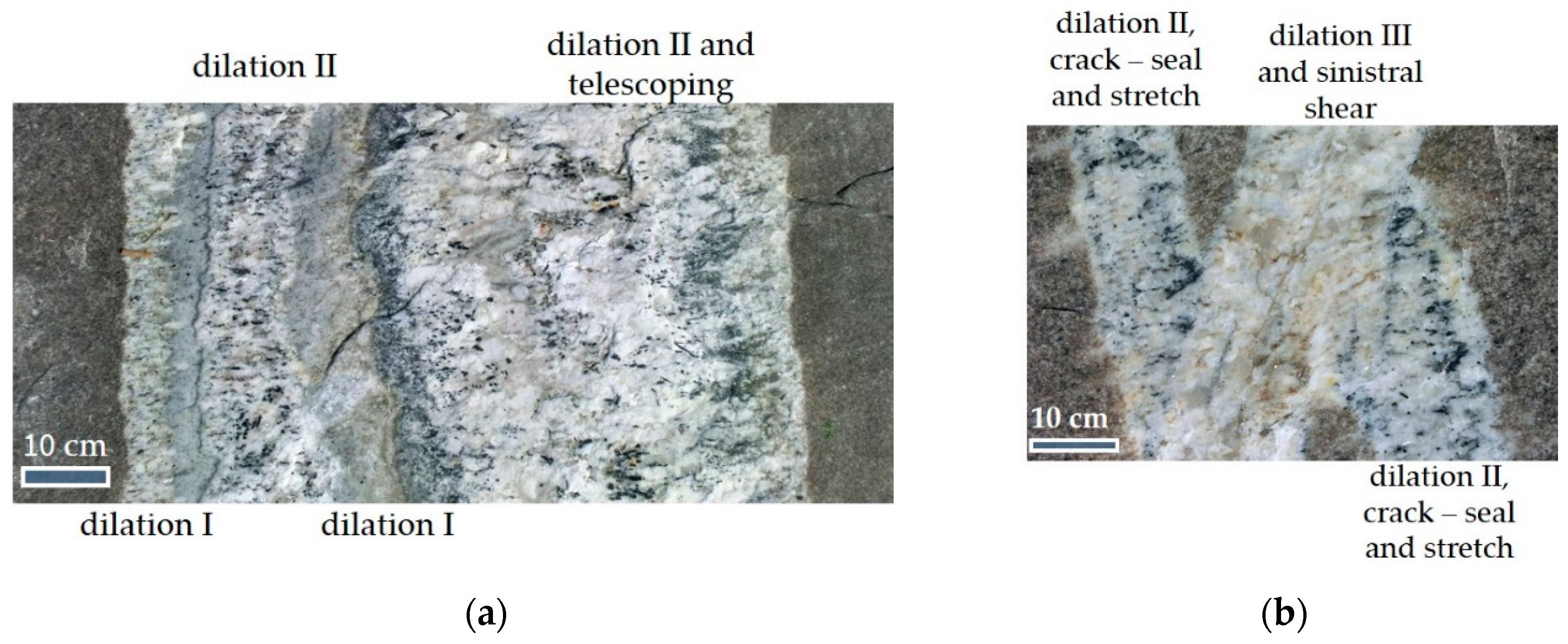
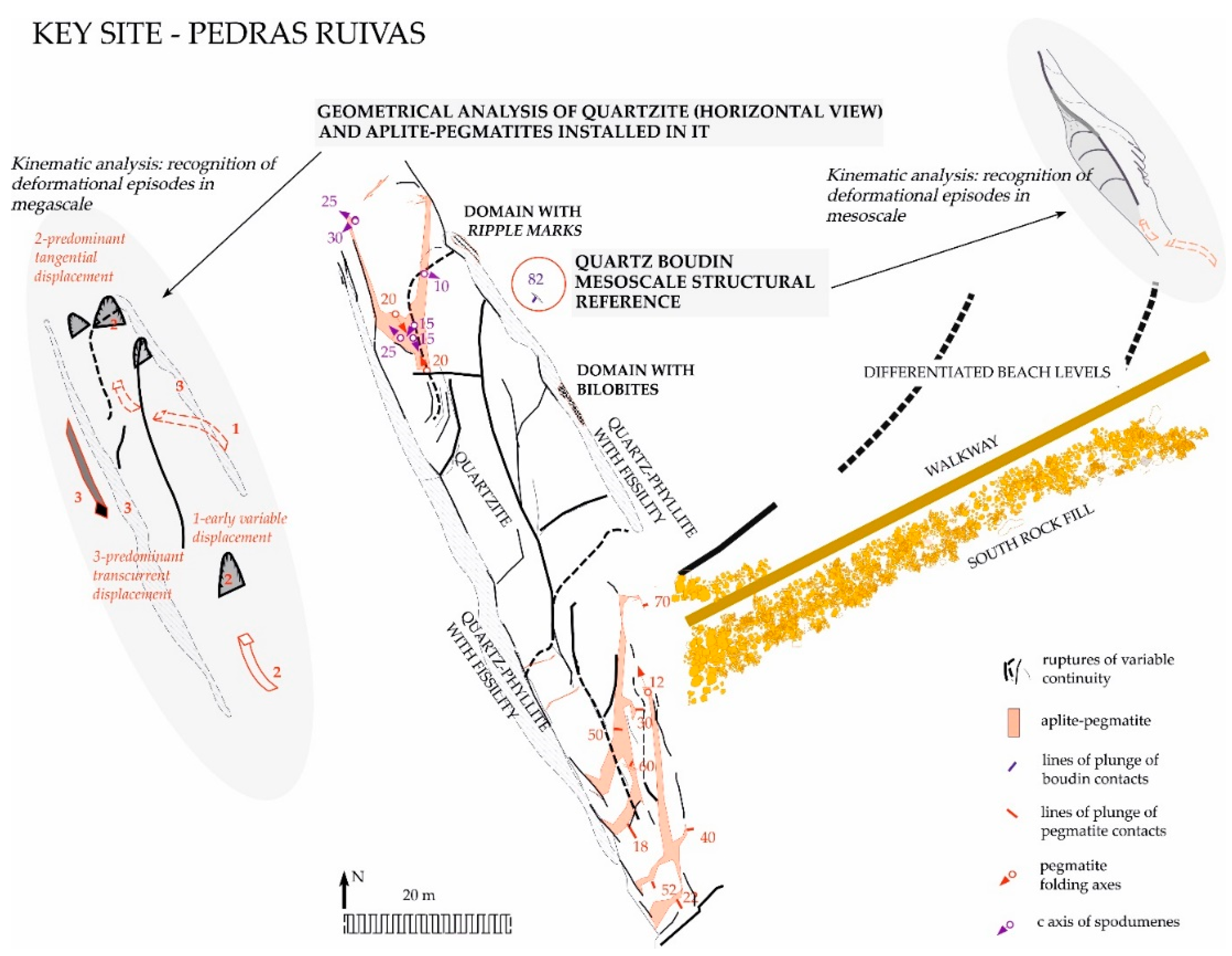

 rossmanite c-axis—defines a rotational deltoid in aplitic flow—rotation under low viscosity and magmatic flow; and (c) cut perpendicular to c of the spodumene + rossmanite.
rossmanite c-axis—defines a rotational deltoid in aplitic flow—rotation under low viscosity and magmatic flow; and (c) cut perpendicular to c of the spodumene + rossmanite.
 rossmanite c-axis—defines a rotational deltoid in aplitic flow—rotation under low viscosity and magmatic flow; and (c) cut perpendicular to c of the spodumene + rossmanite.
rossmanite c-axis—defines a rotational deltoid in aplitic flow—rotation under low viscosity and magmatic flow; and (c) cut perpendicular to c of the spodumene + rossmanite.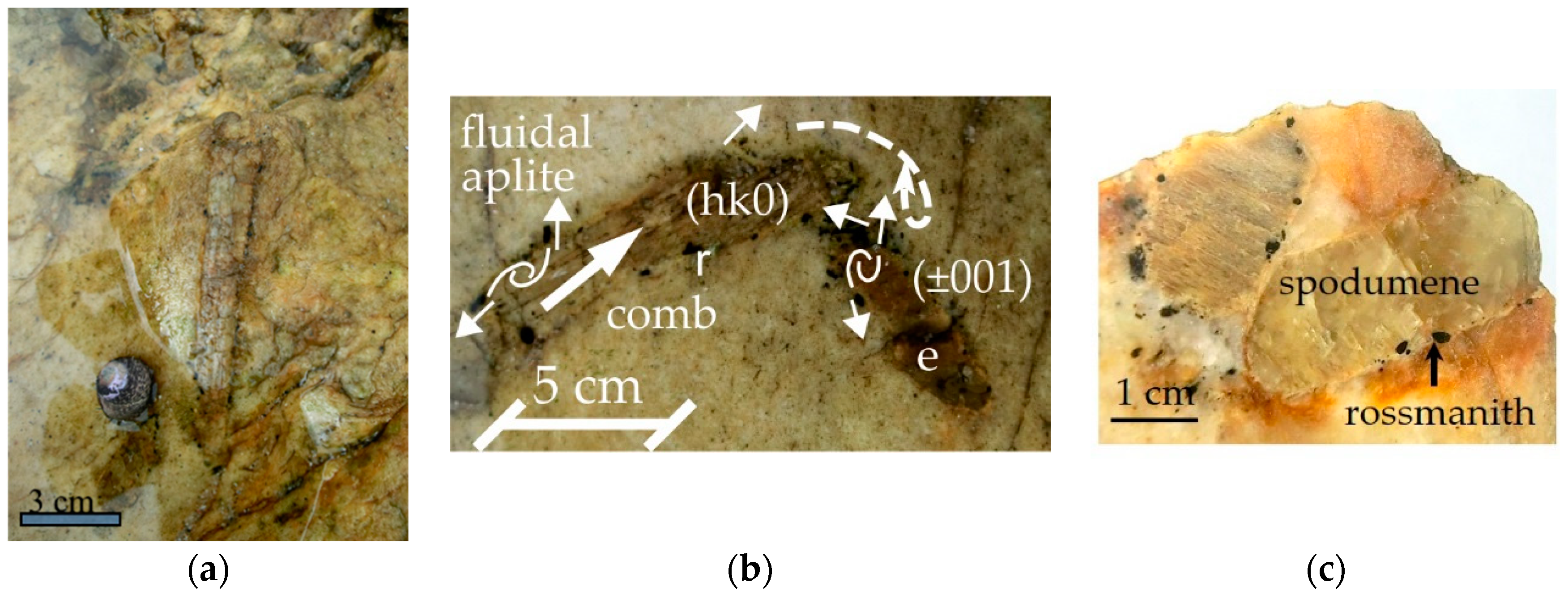
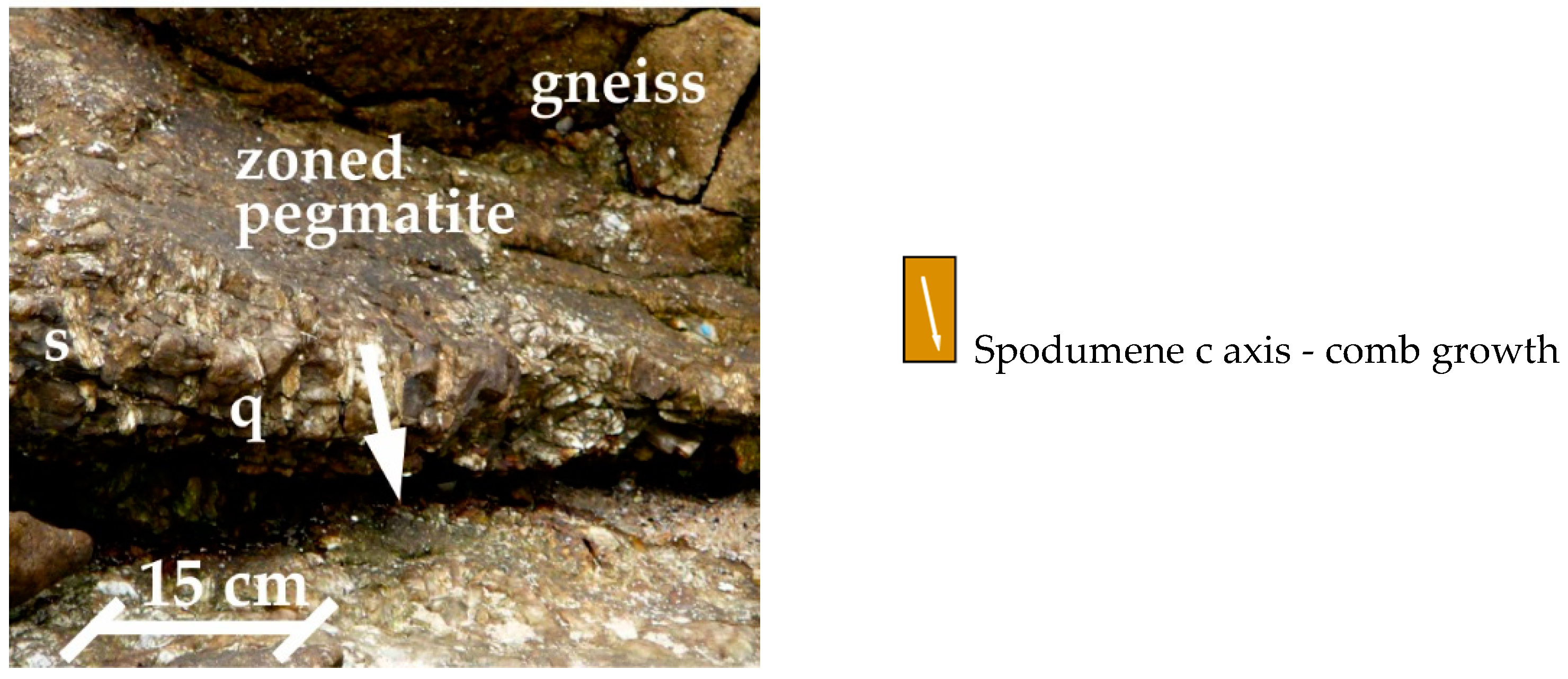
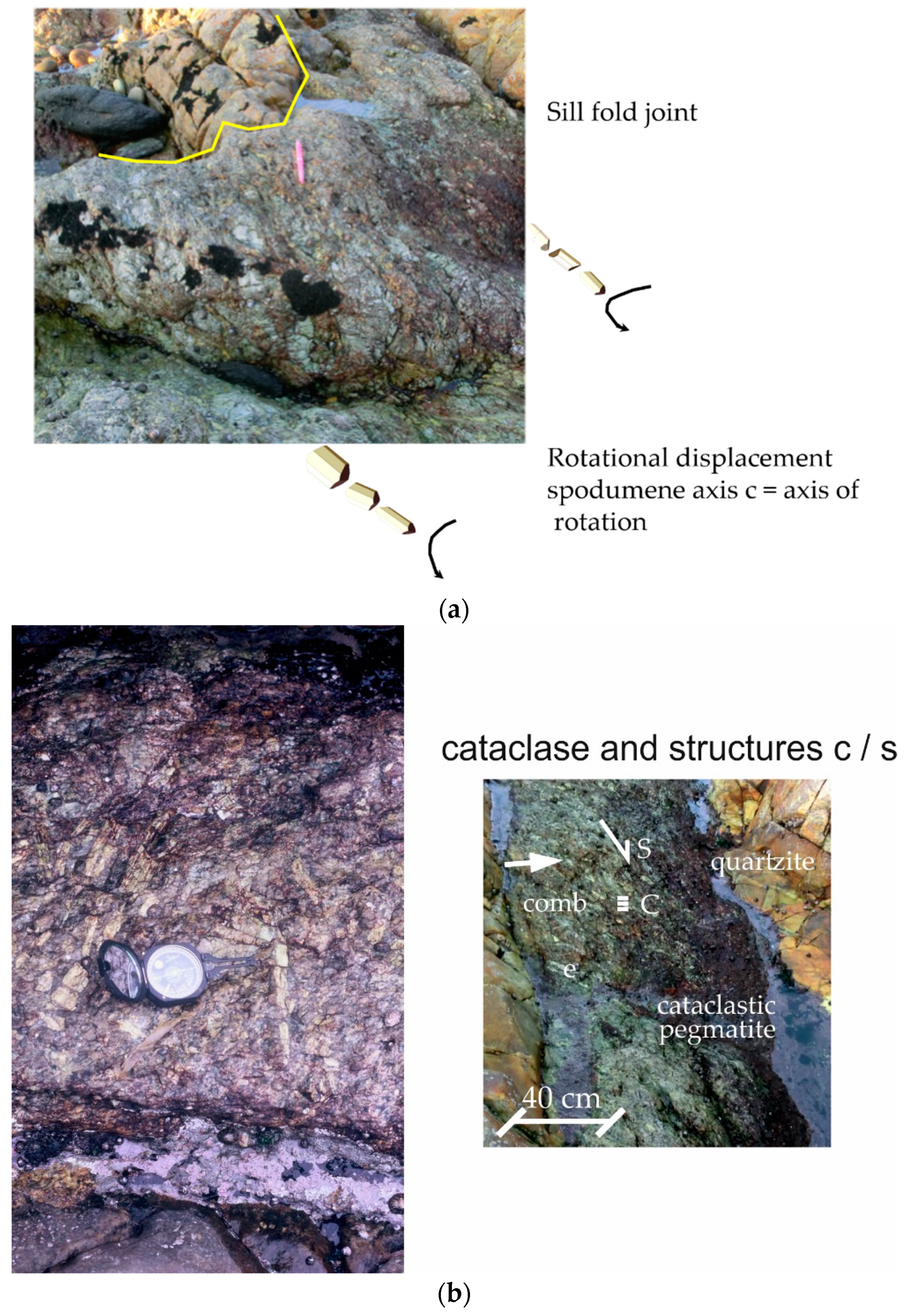
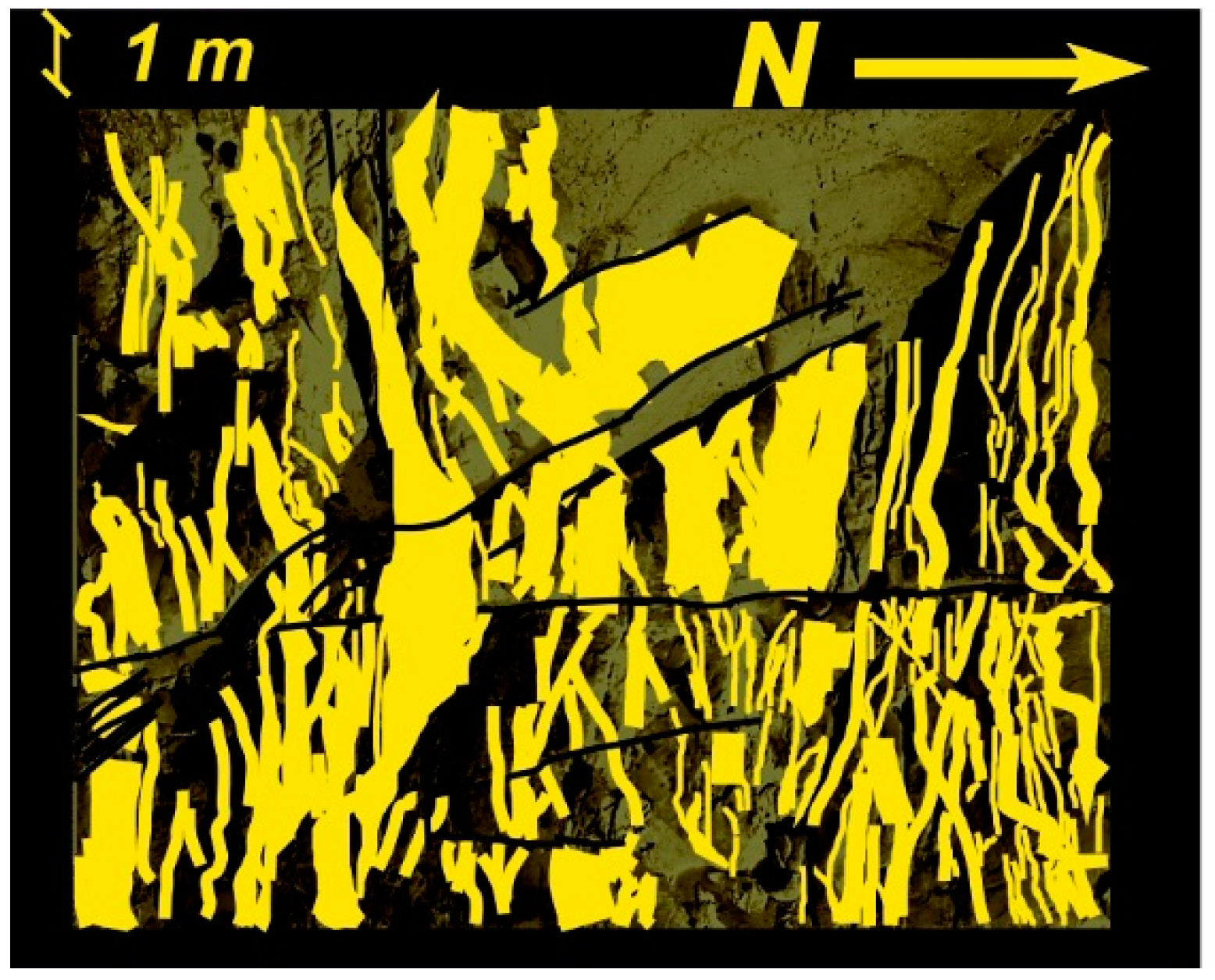
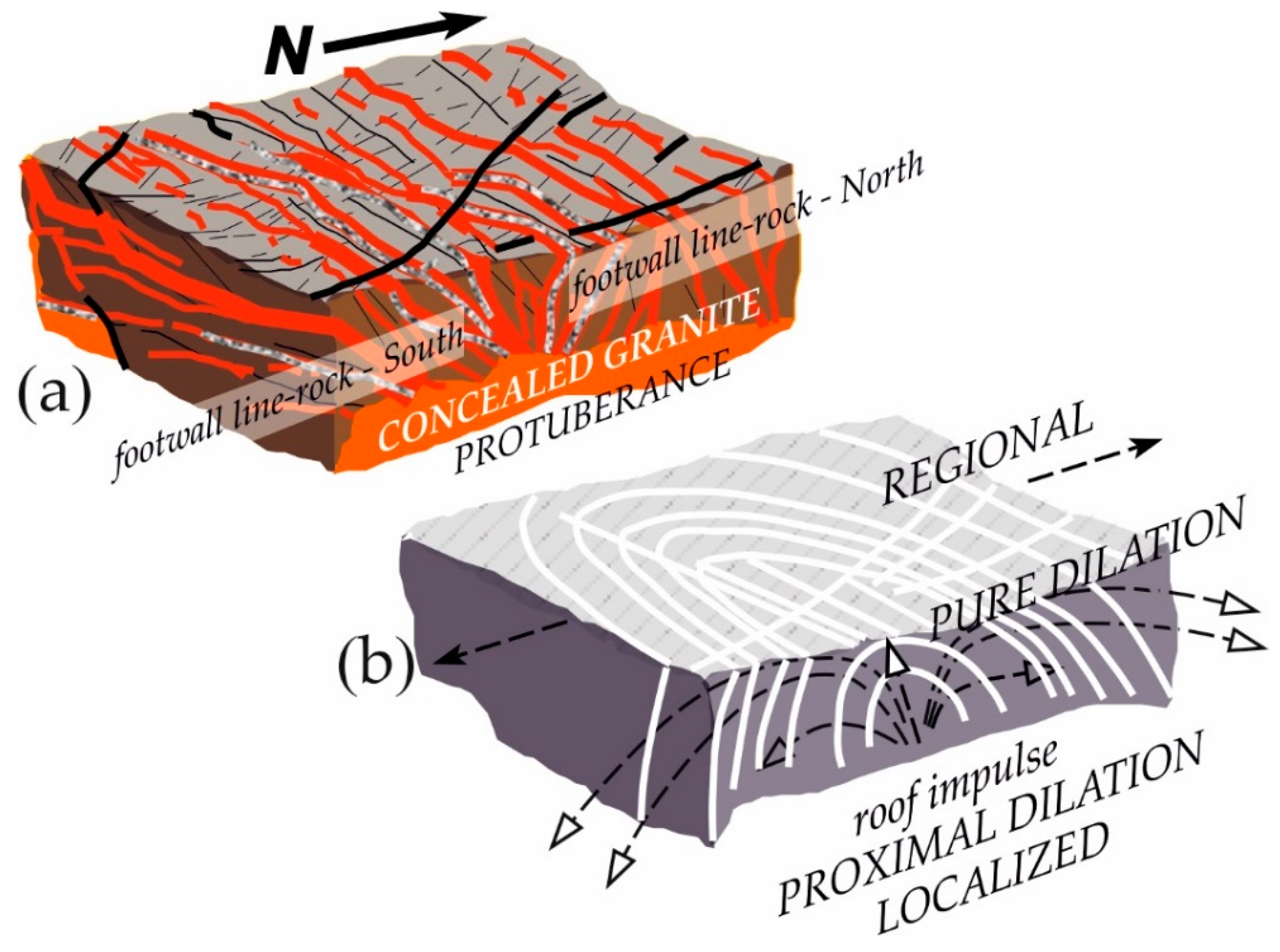
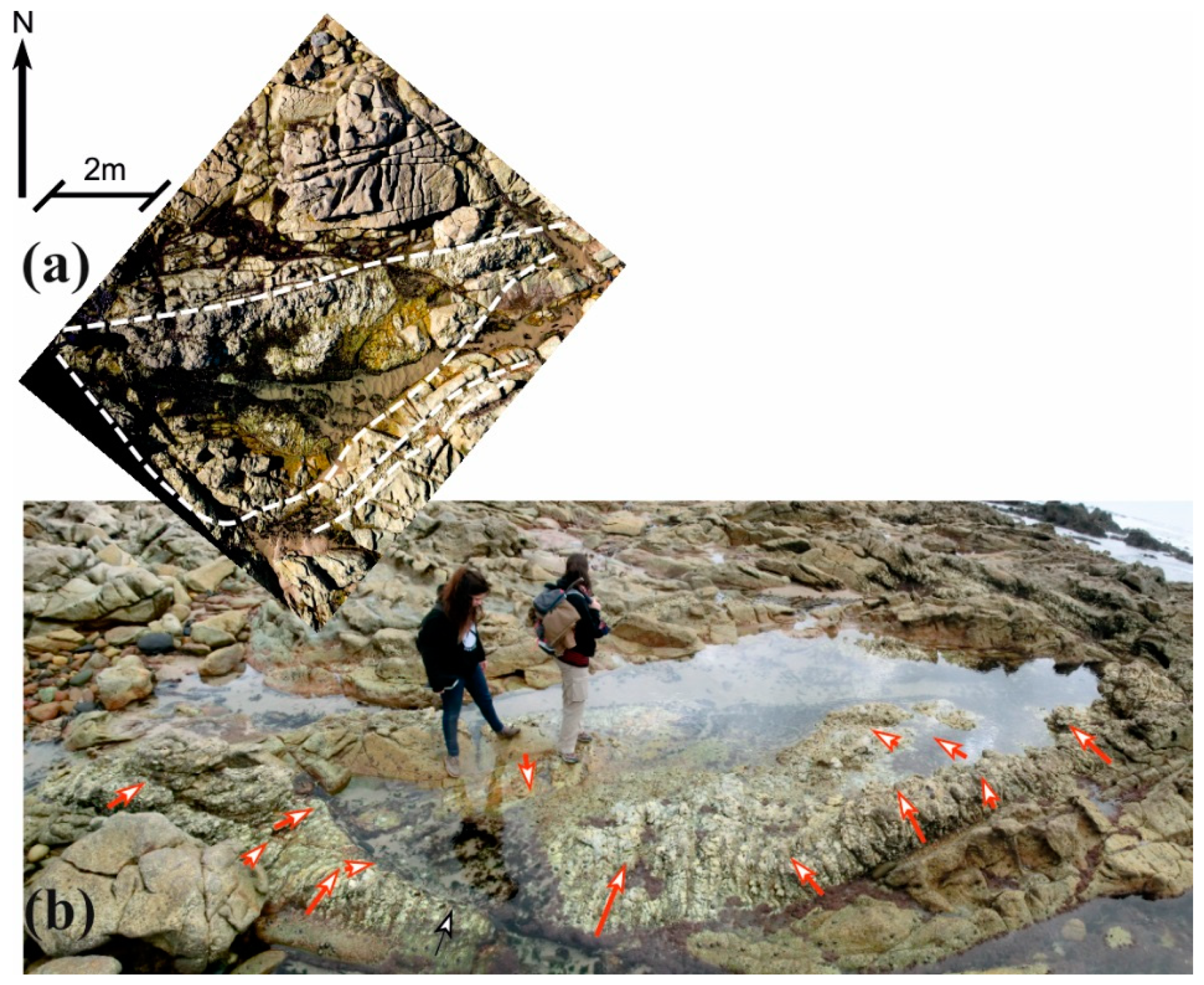


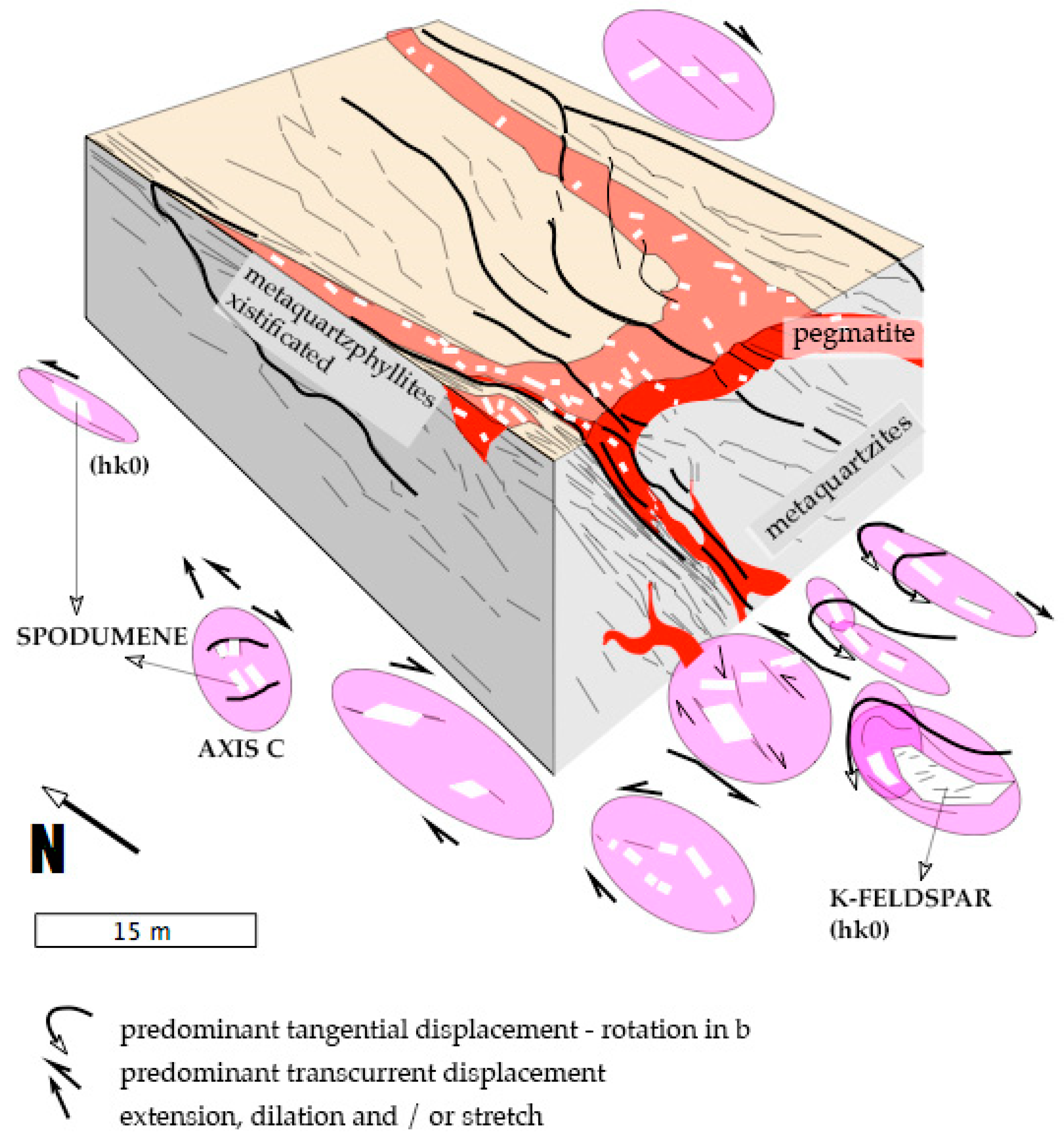
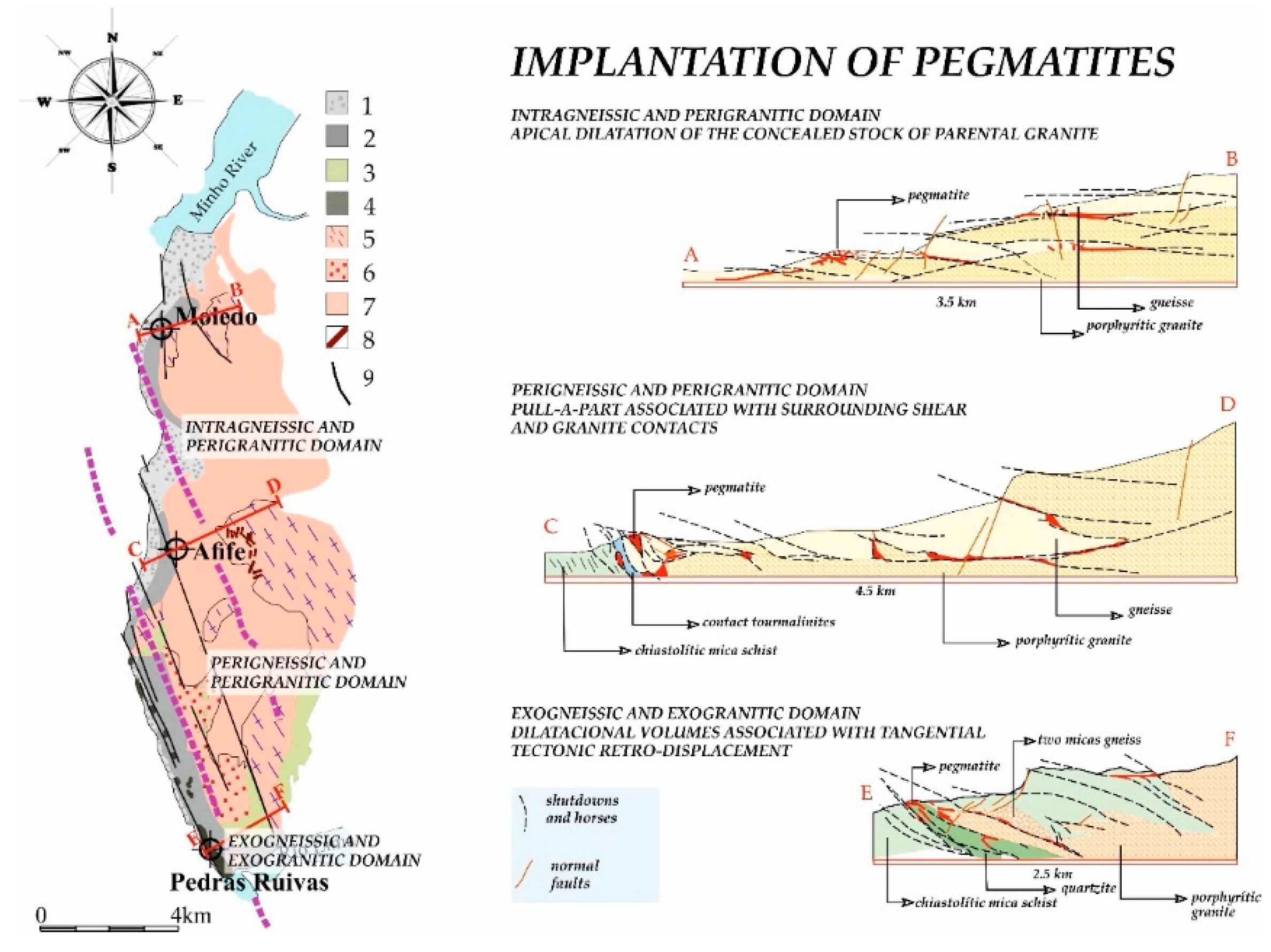
| Lithologies in Cartographic Sketch According to [14]. | Identified Lithologies and Adopted Designations on Sheet 1-C Reviewed by [15]. | ||
|---|---|---|---|
| Moledo | Afife e Pedras Ruivas | ||
 | 1. Recent and Holocene—deposits of dunes and beaches—sand or gravel. | ||
 | 2. Old quaternary—river and marine deposits. | ||
 | 3. Cambrian—alternation of carbonaceous phyllite and siltite. | Tourmalinites—prototurmalinites and contact tourmalinites. | Layered schists to chiastolític metapsamytes Tourmalinites—prototourmalinites and contact tourmalinites. |
 | 4. Lower Ordovician—quartzites, schists and quartz matrix, conglomerates. | Quartzite to metaquartzphyllite with fissility and gray levels with ripple marks and bilobites. | Quartzite to metaquartzphyllite with fissility and gray levels with ripple marks and bilobites. |
 | 5. Two mica granites sin—F3, fine grained, porphyritic. | Porphyritic granite of Carreço | |
 | 6. Two mica granites sin—F3, coarse grained. | ||
 | 7. Two mica granites sin—F3, medium to fine grained. | Gneisses with schlierenitic, supermicaceous, with restitic muscovite-biotitic, occasionally with garnet and tourmaline. | Gneisses with schlierenitic, supermicaceous, with restitic muscovite-biotitic, occasionally with garnet and tourmaline. |
 | 8. Pegmatites | Granitic pegmatites of the class with rare metals, LCT family with spodumene and tantalite-columbite, beryl and amblygonite. | Granitic pegmatites of the class with rare metals, LCT family with spodumene and tantalite-columbite, beryl and amblygonite |
| Lithologies in Cartographic Sketch According to [14]. | Correspondence in the Extended Interpretative Profiles. | |||
|---|---|---|---|---|
| Profile AB | Profile CD | Profile EF | ||
 | 1. Recent and Holocene—deposits of dunes and beaches—sand or gravel. | |||
 | 2. Old quaternary—river and marine deposits. | |||
 | 3. Cambrian—alternation of carbonaceous phyllite and siltite. | Chiastolite Mica schist Contact Tourmalinites | Chiastolite Mica schist | |
 | 4. Lower Ordovician—quartzites, schists and quartz matrix, conglomerates. | Quartzite | ||
 | 5. Two mica granites sin—F3, fine grained, porphyritic. | Porphyritic two micas granite | Porphyritic granite of Carreço | Porphyritic granite of Carreço |
 | 6. Two mica granites sin—F3, coarse grained. | Granites with two micas | ||
 | 7. Two mica granites sin—F3, medium to fine grained | Gneiss | Gneiss | |
 | 8. Pegmatites | Pegmatite | Pegmatite | Pegmatite |
© 2019 by the authors. Licensee MDPI, Basel, Switzerland. This article is an open access article distributed under the terms and conditions of the Creative Commons Attribution (CC BY) license (http://creativecommons.org/licenses/by/4.0/).
Share and Cite
Faria, C.; Leal Gomes, C. Structure of the Granitic Pegmatite Field of the Northern Coast of Portugal—Inner Pegmatite Structures and Mineralogical Fabrics. Heritage 2019, 2, 315-330. https://doi.org/10.3390/heritage2010021
Faria C, Leal Gomes C. Structure of the Granitic Pegmatite Field of the Northern Coast of Portugal—Inner Pegmatite Structures and Mineralogical Fabrics. Heritage. 2019; 2(1):315-330. https://doi.org/10.3390/heritage2010021
Chicago/Turabian StyleFaria, Cristiana, and Carlos Leal Gomes. 2019. "Structure of the Granitic Pegmatite Field of the Northern Coast of Portugal—Inner Pegmatite Structures and Mineralogical Fabrics" Heritage 2, no. 1: 315-330. https://doi.org/10.3390/heritage2010021
APA StyleFaria, C., & Leal Gomes, C. (2019). Structure of the Granitic Pegmatite Field of the Northern Coast of Portugal—Inner Pegmatite Structures and Mineralogical Fabrics. Heritage, 2(1), 315-330. https://doi.org/10.3390/heritage2010021




